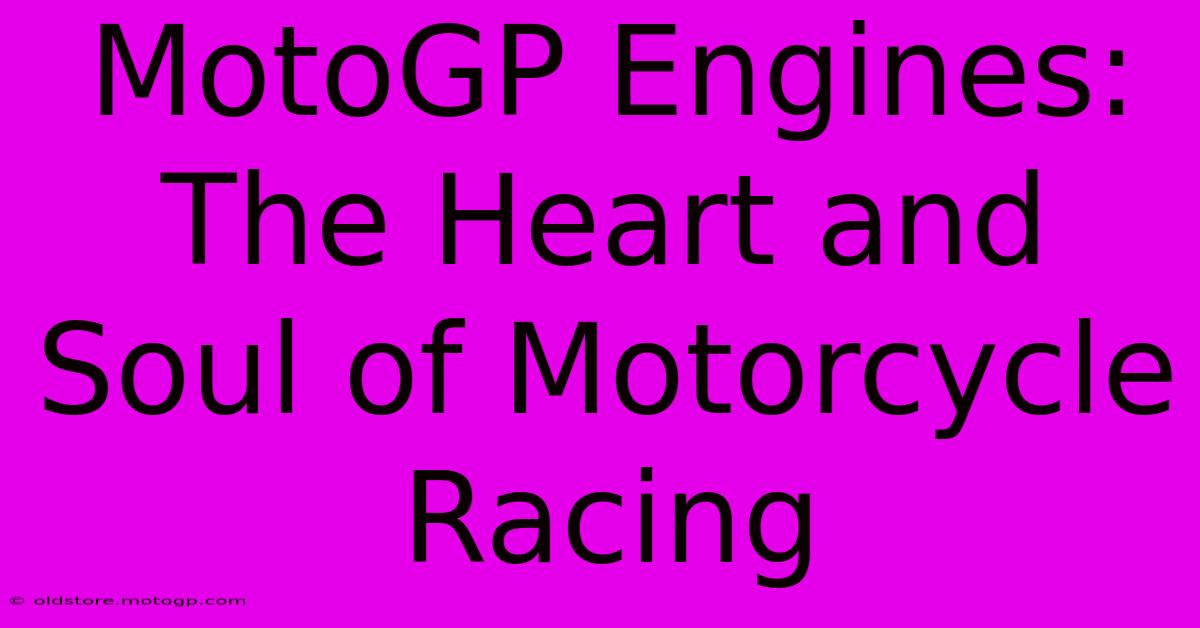MotoGP Engines: The Heart And Soul Of Motorcycle Racing

Table of Contents
MotoGP Engines: The Heart and Soul of Motorcycle Racing
MotoGP, the pinnacle of motorcycle racing, captivates audiences worldwide with its breathtaking speeds and nail-biting competition. At the heart of this spectacle lies the engine – a finely tuned masterpiece of engineering that pushes the boundaries of performance and technology. This article delves deep into the world of MotoGP engines, exploring their design, evolution, and the relentless pursuit of power and efficiency.
The Anatomy of a MotoGP Engine: A Powerful Heart
MotoGP engines are highly specialized, representing the cutting edge of internal combustion technology. These aren't your everyday motorcycle engines; they're meticulously crafted for maximum power output within the strict regulations set by the FIM (Fédération Internationale de Motocyclisme).
Key Characteristics:
-
Four-Stroke, Inline Configuration: Almost exclusively, MotoGP bikes utilize four-stroke, inline four-cylinder engines. This configuration offers a great balance of power delivery, compactness, and manageable vibration.
-
High RPM Operation: These engines are designed to rev exceptionally high, often exceeding 16,000 RPM. This high-revving nature contributes significantly to their immense power output.
-
Sophisticated Valve Train: Typically employing pneumatic valve actuation, these engines use sophisticated valve trains to precisely control the intake and exhaust of the fuel-air mixture at these incredible speeds. This ensures optimal combustion and power delivery.
-
Lightweight Materials: Minimizing weight is paramount in racing. Extensive use of lightweight materials like titanium, magnesium, and carbon fiber is crucial in engine construction to improve handling and acceleration.
-
Advanced Electronics: Engine Management Units (EMUs) play a critical role, controlling fuel injection, ignition timing, and other parameters to optimize performance under varying track conditions. Sophisticated traction control and wheelie control systems are also integral components.
-
Seamless Shifting: Quick-shifters allow for seamless gear changes without the need to use the clutch, crucial for maintaining momentum during races.
The Evolution of MotoGP Engines: A Constant Pursuit of Power
The history of MotoGP engines is a fascinating journey of technological innovation. From the two-stroke era to the current four-stroke dominance, continuous advancements have pushed the boundaries of performance and efficiency.
From Two-Strokes to Four-Strokes: A Paradigm Shift
The transition from two-stroke to four-stroke engines was a significant turning point. While two-strokes offered incredible power-to-weight ratios, they were significantly less fuel-efficient and environmentally friendly. Four-stroke engines, though initially less powerful, offered better fuel efficiency and cleaner emissions, paving the way for the current era.
The Reign of Four-Strokes: Refinement and Innovation
The current four-stroke era has witnessed continuous refinement and innovation. Engineers are constantly exploring ways to extract more power, improve reliability, and enhance fuel efficiency within the regulatory framework. This relentless pursuit of perfection is what drives the constant evolution of MotoGP engines.
The Future of MotoGP Engines: Sustainability and Beyond
As the world increasingly focuses on sustainability, MotoGP is also exploring greener technologies. While the roaring power of combustion engines remains central to the sport, research and development are ongoing into alternative fuel sources and more efficient engine designs.
Hybrid Systems and Beyond: A Glimpse into the Future?
The possibility of hybrid powertrains, incorporating electric motors alongside combustion engines, is a subject of much speculation. While still in its early stages, the incorporation of hybrid technology could potentially improve efficiency and reduce emissions, without sacrificing the thrilling performance that defines MotoGP.
Conclusion: The Engine – The Heart of the Competition
The MotoGP engine is more than just a mechanical component; it's the beating heart of the sport. Its relentless evolution reflects the dedication to pushing the boundaries of technology and performance. The constant quest for power, efficiency, and innovation ensures that MotoGP engines will continue to fascinate and inspire for years to come, keeping the thrilling spectacle alive for fans around the globe. The future of MotoGP engines promises exciting developments, blending performance with a growing awareness of environmental responsibility.

Thank you for visiting our website wich cover about MotoGP Engines: The Heart And Soul Of Motorcycle Racing. We hope the information provided has been useful to you. Feel free to contact us if you have any questions or need further assistance. See you next time and dont miss to bookmark.
Featured Posts
-
Inside The Minds Of Moto Gp Qualifiers
Feb 25, 2025
-
Own The Track Cota Circuit Days
Feb 25, 2025
-
Experience The Spectacle Of F1 At Club Si Austin F1
Feb 25, 2025
-
Moto Gp Sprint Race Where Passion Meets Performance
Feb 25, 2025
-
Staying In Control Best Motorcycle Racing Throttle Control
Feb 25, 2025
